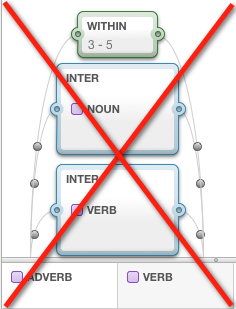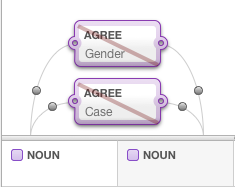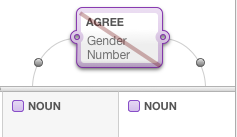Using Multiple Connecting Items
You can use the same connecting item more than once between the same two elements. The most common example is when one item is negative and the other is positive. This lets you specify not only what must be true about matching forms but also what cannot be true.
Multiple Connecting Items with Greek ExamplesMultiple Connecting Items with Greek Examples
 The positive AGREE item specifies that the elements must be from the same lexical form
The positive AGREE item specifies that the elements must be from the same lexical form![]() The canonical (dictionary) form of a word. The negative AGREE item specifies that they cannot agree in voice. This construct finds places in which the text shifts from the active
The canonical (dictionary) form of a word. The negative AGREE item specifies that they cannot agree in voice. This construct finds places in which the text shifts from the active![]() The application, window, tab, or other screen element which is currently being used; sometimes called the "front" or "frontmost" screen element to the middle voice (or vice versa) for the same verb.
The application, window, tab, or other screen element which is currently being used; sometimes called the "front" or "frontmost" screen element to the middle voice (or vice versa) for the same verb.
 When you specify the same connecting item multiple times between two elements, the words in the text must match the definition of all of the items. For example, the construct on the left does not find any verses because the two INTER connecting items have been defined in such a way that it is impossible to match both definitions.
When you specify the same connecting item multiple times between two elements, the words in the text must match the definition of all of the items. For example, the construct on the left does not find any verses because the two INTER connecting items have been defined in such a way that it is impossible to match both definitions.
In this case, the WITHIN item specifies that there must be intervening words. However the INTER connecting items constrain any intervening word to be both a noun and a verb, which is impossible.
(If the NOUN tag and the VERB tag were in the same INTER item, the intervening form could be either a noun or a verb.)
Multiple Negative AGREE ItemsMultiple Negative AGREE Items
A negative AGREE relationship often requires the use of multiple items. Usually, no two items specify information for the same tag detail. For example, to specify that two elements must not agree in gender and must not agree in case, separate negative AGREE items must be used.
Greek Examples with Multiple Negative AGREE Items
| Correct Placement | INCORRECT Placement |
|---|---|
 |
 |
| This example specifies that the nouns must not agree in both gender and case. | This example excludes adjacent nouns which agree in both gender and case. As a result, nouns are found which do not agree in gender, or case, or both. |
Hebrew Examples with Multiple Negative AGREE Items
| Correct Placement | INCORRECT Placement |
|---|---|
 |
 |
| This example specifies that the nouns must not agree in both gender and number. | This example excludes adjacent nouns which agree in both gender and number. As a result, nouns are found which do not agree in gender, or number, or both. |